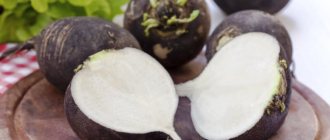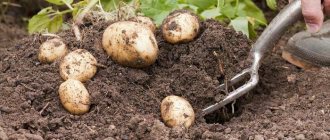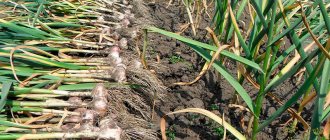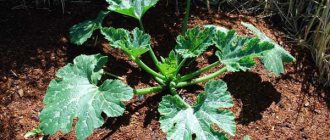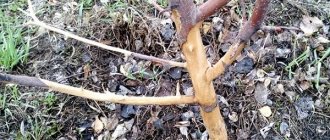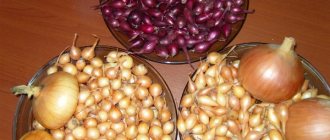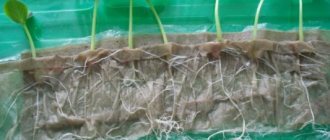Description of culture
Green radish differs from its counterparts - black and white - in having a milder taste. It also has the following characteristics:
- divided into early, mid-season and late varieties;
- root vegetables are round and elongated;
- the body of the root crop is short - up to 15 cm, and wide - up to 10 cm in diameter;
- color – white, bright green, pink, red and purple;
- the pulp can also be of different colors;
- the part near the tops is always green;
- the average weight of one fruit is 500 g, but some specimens grow up to 1 kg;
- the pulp is moderately dense and juicy, without pronounced pungency;
- average yield – 6 kg/sq. m;
- root vegetables have good keeping quality;
- tolerates transportation well;
- reaches technical maturity in the period from 60 to 90 days.
Preparatory stage
In order for radish planting to be successful, and for the plants to grow and develop well, you first need to prepare a plot for them, the soil on it, as well as seed material.
The best predecessors
It is preferable to sow radishes after legumes, cucumbers, pumpkins, tomatoes, peppers, dill, onions, corn and other plants from these families. Radishes should not be planted after cruciferous vegetables so that they do not become infected with common diseases.
Site selection and soil preparation
The beds where the radishes will grow are arranged in a sunny, open place. Radish does not like waterlogging, so you need to choose a place where groundwater does not come close to the surface.
The soil that radish prefers is sandy loam and loam, fertile, saturated with humus, with a neutral or slightly acidic reaction. Acidic soils need to be limed. Fertilizers are applied during autumn digging and soil preparation: for each square. m add 1-2 buckets of humus, compost, peat, 0.5 buckets of sawdust and up to 0.5 kg of ash (or 2 tablespoons of nitrophoska and 1 tablespoon of superphosphate). All this is embedded in the soil, the lumps of earth are not broken so that they freeze in winter.
When applying fertilizers in spring, use 10-15 g of urea, 30-40 g of superphosphate and 15-20 g of potassium chloride per square meter. m.
Seed preparation
The radish seeds that will be used for sowing are pre-selected: pour them into a cup, fill them with a 5% saline solution (50 g per 1 liter) and leave until some of them float to the surface. They are drained together with water, the rest are washed with clean water, then soaked for 0.5 hours in potassium permanganate (take 0.2 g of the drug per 1 liter), and then in warm water for a day. Then they dry it.
We recommend reading
Growing asparagus (green) beans, care
Technology for growing turnips in open ground, care
The benefits and harms of turnips for human health, contraindications
Review of Margelanskaya radish: planting and care
The best varieties
There are many varieties of this vegetable, however, the following varieties are the most popular in our country:
- Early ripening:
- Green Goddess is a fairly new variety, characterized by an interesting taste with a slight spice. The shape is round, the color is green, the flesh is tender and crispy. The harvest can be stored for a long time. The weight of the fruit is 400 g, ripens in 60-63 days.
- Southern - characterized by high yield, shape - oval-round, peel color - greenish, fruit weight - 250 g, juicy pulp, color - white.
- Severyanka - growing season - 60 days, shape - obovate with a sharp base, large pink head. The pulp is tender, juicy, with a sweet-sharp taste, the weight of the root crop is 500-890 g.
- Aelita - ripens 65 days after the appearance of the first shoots. The fruit has an elliptical shape and is green in color. Fruit weight is 200-400 g, the pulp is tender, sweet and juicy, the taste is slightly spicy.
- Mid-season:
- Lobo is a Chinese species with large fruits, round or elongated. The weight of the root crop is 500 g and above, the color is light or dark green, pinkish, red and purple. The taste is delicate, slightly spicy, without bitterness. Ripen in 60-90 days.
- Pink ring - the shape of the root vegetable is oval, the color of the peel is light green. The flesh is pink with a red ring.
- Late ripening:
- Oktyabrskaya-1 – the growing season is 75 days, the shape of the root crop is round-oval, the color of the peel is white, the head is green, the pulp is white, tender, juicy, the taste is mildly spicy.
- Troyandova – growing season – 80-85 days. The shape of the vegetable is oval, the color is pink. The weight of the root crop is 670-700 g, with delicate pulp, the taste is pleasant with bright shades, the yield is 6-7 kg per 1 sq. m.
Popular types and varieties of radish
Radish is very diverse and can differ in shape, size, color (there are white, yellow, green, black, purple, red root vegetables). The crop is mainly divided into summer and winter radishes. Let's look at popular types and varieties of crops:
- White radish (Russian). A popular variety with a delicate taste and juicy. Most often consumed fresh. Popular varieties are: Delicacy, Sudarushka, Sirius, Summer Round White, Rex.
- Black radish (Bitter). It has many beneficial properties for humans and has a rich, bright taste. It is considered to be the most useful variety. Popular varieties of black radish: Winter long black, Divnaya, Lekar.
- Margelan radish (Chinese or Loba). It has a milder taste than the above varieties, is practically not bitter, is similar in taste to radishes, and is most often consumed fresh. Varieties: Margelanskaya, Ladushka, Elephant Fang, Sultan, Zarevo.
- Daikon (Japanese or Sweet radish, Bailobo). It also has a mild taste without bitterness, and is very healthy. The following popular varieties can be distinguished: Caesar, White Sun, Japanese White Long, Emperor, Ice Con, Dubinushka, Minowasi, Dragon.
- Green radish. Because of its pleasant, delicate taste, it is most often consumed raw; it contains many useful vitamins and minerals. Popular varieties: Green Goddess, Aelita.
Pre-sowing activities
Before planting radishes, carry out several pre-sowing activities. It is necessary to choose a place for planting, prepare the soil and seed material.
Selecting a location
Choose a place with good lighting and follow the rules of crop rotation. Radish is unpretentious to soil acidity; it grows well in both neutral and alkaline soils. According to the structure, choose loams or sandstones.
If the soil is too acidic, then it is better to deoxidize it with dolomite flour at the rate of 400 g/sq. m. The soil must be carefully dug up without breaking the earthen clods. Lighten heavy clay soils with peat and sand. You can spread compost and peat if you plan to plant in spring - 6 kg/sq. m.
Predecessors
Green radish should be planted after the following crops:
- nightshades;
- cucumbers;
- Luke;
- garlic;
- melons
You can replant any type of radish in one place only after 3-4 years. This root vegetable should not be grown after silage crops, corn, and cabbage.
Seed preparation
First, calibrate the seeds and sort them. You should know that seeds can retain their quality for 4 years. If the expiration date has passed, then you need to get rid of them.
Select the largest and most even seeds. To increase germination, soak them with the addition of growth stimulants, for example, 2 drops of Epin per 100 ml of water, and leave for 4 hours. This should be done the day before sowing. Dry the seeds thoroughly.
Why radishes go to arrows and what to do
It often happens that powerful plants, instead of forming roots, begin to bush heavily and shoot out arrows. There may be several reasons for this.
- Inconsistency of planting time with variety requirements.
- Too hot weather and insufficient watering.
- Too much organic fertilizer in the soil (radish “fatten”).
If the plant shoots out an arrow, then you will have to part with it. The root crop will be underdeveloped and tough. Sometimes one or two of these flowering plants are left for seeds to ripen and reproduce further. But bolting plants are not suitable for food.
The appearance of an arrow on several plants indicates errors in care. If the planting date is chosen too early, the harvest can be saved by artificially shortening the daylight hours. It is necessary to cover the radish bed, limiting the sunny day to 10 - 12 hours.
If bolts appear due to a long period of heat, then bolting can be avoided by watering in small volumes in the morning and evening. This stimulates the growth of root crops.
Reducing soil nutrition is much more difficult. You can try to acidify the area. In acidic soils, organic matter is less readily absorbed by plants. To correct the pH, you can water the radish with a solution of citric acid at the rate of 2 tbsp. on a bucket of water. The acidic liquid is applied by uniform watering no more than twice during the entire development of the plants.
Sowing in open ground
Factors influencing planting timing:
- period of technical maturity of varieties;
- climate;
- length of day;
- purpose of landing;
- care features and planting method.
The optimal timing, depending on the region, is as follows:
- Central Russia - late April - early May. Can be planted from autumn to winter.
- Urals - second half - end of April.
- Siberia - the first half of April, if the temperature is at around 4 degrees Celsius.
Planting radishes in open ground is carried out in several stages:
- Dig up the soil using a spade, remove weed roots and tree shoots.
- Grow radishes in raised beds. Use boards for this - raise the soil by 100-150 mm, cover the surface of the bed with a nutrient solution of organic matter and mineral fertilizers, and level the surface.
- In a 1 m wide bed, make 3 rows 30 cm apart. The depth of the grooves should be 3-4 cm.
- Water the rows generously. When it is absorbed into the ground, spread the seeds along the grooves, keeping an interval of 10-15 cm between them.
- Mulch the grooves with humus or peat.
- In case of nest planting, place the holes in a checkerboard pattern and sow up to 5 seeds in each hole.
- If the seeds were soaked before sowing, then shoots appear on the 5th day, dry ones sprout a few days later.
- To speed up germination, water the bed and cover it with non-woven material.
Radish can survive cold spells and even slight frosts, and the seeds will germinate at temperatures of +3 - +5 degrees. The optimal air temperature for the successful growth of green radish is 18-20 degrees Celsius.
When to plant radishes according to the lunar calendar in 2021
For those who follow the advice of the lunar calendar, we advise planting radishes only on certain, favorable days:
- in March – 1.5, 23-25, 28.29;
- in April – 2, 20, 23, 25, 26, 29,
- in May - 4, 21, 23, 26, 28;
- in June - 1.19, 24, 29;
- in July - 20, 25, 30.
Remember that unfavorable days for planting radishes:
- in March - 6, 21;
- in April - 5, 19;
- in May - 5, 19;
- in June - 3, 17;
- in July - 2, 17.
Care
In addition to proper fit, providing suitable care is also an important factor. Despite the frost resistance of the crop, it is necessary to monitor the temperature and avoid sudden changes.
Watering
Radish loves water - you need to water often and a lot, especially if the weather is hot and sunny. From a lack of water, root crops become coarser, less juicy, and with an uneven supply of water they begin to crack.
First-term plants planted in early spring should be watered at least 2 times a week, and summer-planted plants should be watered 3-4 times per season. The water norm is 10 liters per 1 sq. m beds. After moistening, it is advisable to mulch the soil to reduce the number of waterings due to longer moisture retention.
Thinning
A necessary procedure due to the fact that several seeds are placed in the holes at once. It is carried out in 3 stages:
- for the first time when a few true leaves appear on the seedlings. You need to remove the weakest plant.
- The second time - when the rudiments of the future root crop appear. Remove any plants without green color or foliage.
- The third time - when the root crops reach a diameter of 0.5 cm. Remove the smallest and weakest ones so that in the end there is only one plant left in the hole.
Plants should be carefully pinched and not pulled out, so as not to disturb the sprouts, which should remain in the ground.
Loosening and hilling
It is necessary to soften the earthen ball so that air can flow freely to the roots. When the top of the root crop grows 1-2 cm above the ground surface, it needs to be hilled up, otherwise this part will become coarse.
Radish does not tolerate the crust that forms on the soil surface, so loosen the soil after rain - the procedure destroys the channels through which moisture collects. Remember, loosening is “dry” watering.
You need to loosen the soil in the rows and furrows, to a depth of 4-6 cm. With deeper loosening, the root system of the radish can be damaged, and weed seeds are turned out of the deep layers of the soil closer to the surface.
Weeding and removal of tops
Excess foliage and weeds prevent fruits from fully developing and are a breeding ground for the spread of diseases and pests. Excessive thickening causes the formation of flowering shoots.
Be sure to pick off all dry leaves, and if the tops create dense shade, remove healthy lower leaves as well. Weeds must be removed constantly, combining the procedure with loosening.
Feeding
During the growing season, fertilizing is necessary at least twice. If there is a need for any mineral during the period of fruit formation, then another feeding will be needed:
- Feed for the first time after the first thinning - fill the bed with wood ash - 1 tbsp. per 1 sq. m.
- The second time is during the ripening of the fruit. Plants are fertilized with nitrophoska, diluting 30 g of the substance per bucket of water.
If during ripening the leaves begin to turn pale, then you can feed the radish with mullein solution or scatter the ash over the beds again.
Favorable days for planting radishes
Interest in culture was temporarily lost, but now there are improvements. Summer residents find time and place to grow healthy vegetables. And that’s right, red juice has unique healing properties; it benefits the body no less than garlic and horseradish.
People in Russia knew about this already in the 12th century, so radish was used to treat colds, kidneys, liver, stimulate the gallbladder, and dissolve stones. The root vegetable was used to make a stew, make kvass-based tyurya, and a filling for dumplings and pies. Orthodox Christians ate huge amounts of black radish during Lent. Those who grow vegetables in the country have no problems with storage in winter; they remain in the cellar until spring.
By the moon
Black radish seeds are sown twice during the season. In the spring, if they want to grow a crop for summer consumption, in the summer - for storing it for the winter. Large root crops are formed if sowing was done during the waxing moon in the signs of Taurus, Capricorn, Sagittarius and when the waning star passes the constellations Cancer, Taurus, Scorpio, Pisces, Capricorn.
According to popular belief, a good harvest of radishes and carrots was dug up if the seeds were sown on the day of the gardener's Kuzma. It falls on May 1st.
To prevent all the radish’s energy from going into the tops, it is not sown on the days of full moons and new moons; here is a list of them for 2021:
- April – 7-9, 22-24;
- May – 6-8, 21-23;
- June – 4-6, 20-22;
- July – 4-6, 19-21.
The best landing days by month are shown in the table.
| Month | Dates |
| April | 11-12, 17-19 |
| May | 9 |
| June | 16-18 |
| July | 8-10, 13-15 |
By variety
There is a short description on the seed packet. In it, the manufacturer indicates the ripening period of the root crop. Having studied this characteristic, the summer resident determines whether he needs this variety or not and when to plant it. Summer varieties are sown in the spring; they have a short growing season; winter varieties are sown in the summer; they require 90-110 days to ripen. Plant juices rush to the roots, and the aboveground part becomes drier when the Moon wanes. These days it is good to fertilize and water vegetables.
Proven varieties for the 2021 planting season:
- Winter black round. Root vegetables are eaten in autumn and winter. They are round-flat with a diameter of 8-12 cm, a length of about 10 cm, weighing 250-500 g. The taste of the pulp is slightly pungent.
- Skvirskaya black. Weight 300 g. Shape round, flat-round. The variety is resistant to flowering. Keeping quality is good.
- Levina. Weight 500 g. The fruits are leveled and shelf-stable.
- Radish "Semko" Chernavka. The heads are round, flattened, weighing 240-260 g, with a diameter of 8-10 cm. The pulp is juicy, the taste is slightly spicy. Mid-season variety for summer sowing (mid-July). Stores well in winter.
- Night.
- Doctor. The taste is slightly spicy. Weight 280 g. Round shape.
- Healer. Diameter 8-10 cm, weight 200-300 g. Taste pungent. This variety is planted for the winter and lasts until spring.
Main diseases and pests
For green radish, the danger comes from diseases and parasites that affect the cruciferous family.
| Diseases, pests | Symptoms | Fighting methods |
| Gray rot | A fungal disease that develops during storage. Symptoms are the formation of a gray fluffy coating on the fruit. | The use of drugs containing Gliocladium (a fungus that eats other mushrooms). |
| Powdery mildew | It is characterized by a whitish-gray coating, which leads to stunted plant growth. | Compliance with the rules of crop rotation, isolation of seedlings in space, treatment with special preparations (Bordeaux mixture). |
| Blackleg | The leaf rosette becomes thinner and a mycelium appears. The top of the fruit and the lower part of the stem become black, and a white coating forms. | Thinning the plants, changing the soil, using 1% Bordeaux mixture with adding a layer of sand after the procedure. |
| Mosaic | Brown patterns gradually appear on the leaves. | There is no cure, you need to burn the affected plants. |
| Slugs | Damage tops and protruding parts of root crops | It is recommended to collect and destroy pests, as well as pour a thick layer of crushed eggshells or lime. |
| Cabbage flies | They feed on nectar, the larvae gnaw through tender roots, build tunnels, the radish begins to look depressed, and the tops wither. | Damaged root crops need to be dug up and burned, and the soil should be treated with an insecticide (Aktara, Karbofos). |
| Black fleas | They scrape out the skin from young leaves and stems, and the larvae eat the roots. | Maintaining a moist environment, dry pollination of leaves (with a mixture of ash and tobacco dust in a 1:1 ratio). Treatment with insecticide solutions (Decis, Sherpa). |
Possible problems and difficulties
Planting dry seeds .
At the same time, seed germination is significantly reduced. Corrective measures: keeping the soil moist, covering the beds with protective material.- Planting untreated seeds leads to seedlings becoming infected with pests.
When the first signs of the disease appear, the plants are treated with a 1% solution of boric acid, Bordeaux mixture, and copper sulfate. - Small fruits .
Growing the crop requires slight rocking of the root crop, which helps prevent the development of lateral shoots of the roots, as a result of which the fruit grows large and dense. - Shooting .
Radish is prone to shoots if not properly cared for, the main reason being cold. To avoid this, it is necessary to constantly keep the soil moist, cover the beds with film, and prevent the beds from thickening (regular thinning). - Cracking of root vegetables .
Occurs when watering is disrupted, when the soil remains dry for a long time. To avoid cracking, the soil is constantly kept moist. - Premature flowering .
Its development is facilitated by insufficient thinning, then the above-ground part of the plant begins to increase. Prevention - proper thinning according to a specially developed scheme.
Black radish is a cold-resistant plant with juicy, strong roots, which is grown in open ground and in a greenhouse with minimal care conditions. The unpretentiousness of the plant allows you to get a large harvest that can be stored and used in cooking, animal husbandry and medicine all year round.
When and how to harvest?
Harvest time for green radish depends on the variety. It is important to note the number of days that have passed from sowing to ripening:
- Summer varieties should be harvested in early June. Such root vegetables have a short shelf life.
- Autumn varieties are harvested before the end of summer.
- Winter radishes need to be collected before the first frost.
The ripening of root crops usually takes two to three months after planting. Early varieties begin to be harvested after 50-70 days, and mid-season and late varieties after about 75-100 days.
Clean in dry weather, in the morning or evening, when the sun is not very active. If the soil is light, then you need to pull out the radish, holding it by the tops at the base, and on heavy soils, use a shovel. The tops need to be cut off, leaving only 2-3 cm.
Harvesting
Root crops are dug out from open ground as they mature. When growing early ripening white radish, this occurs in July–August. Later, winter varieties are stored for storage before frost at the end of September.
Root crops are dug up with a pitchfork or pulled out if their location is shallow. The tops are cut off, leaving a few centimeters of the stem.
The vegetable should be stored in a cool, dry place. You can put them in boxes with sawdust or line them with paper. Some housewives store radishes in containers filled with dry sand.
Storage
Keep the harvested crop in the garden for several hours to dry. During this time, sort through the radishes, selecting damaged roots for use as food, and place healthy ones, without cracks or cuts, in bulk in a basement or cellar.
You can store the harvest in plastic bags with the neck slightly open. Sand containers are also suitable for storage. Storage temperature is +1-2 degrees, and the air humidity level in the room or bag should be 80%.
Storage on the balcony is possible if in winter the temperature there does not fall below 0 degrees. Vegetables should also be placed in boxes and sprinkled with sand. In the refrigerator, radishes should be placed on the shelf for storing vegetables in bags with holes made.
A gardener will tell you about his experience of growing green radishes in the following video:
Green radish is a crop that gardeners love very much and plant it on their plots because it requires virtually no care. Planting the seeds of this root vegetable is not difficult, and they have a high germination rate.
0
0
Copy link
Pest Control
Radish, like other plants, is susceptible to the influence of pests; in order to effectively fight them, you need to know the main symptoms of their appearance and take timely measures to localize them.
These symptoms include:
- the appearance of black spots on the stems,
- slow growth of tops and the appearance of ulcers on them,
- the appearance of holes in the root crop.
If these symptoms are detected, you must immediately take measures to combat insects.
The list of main radish pests includes:
- cruciferous flea beetle,
- white butterfly caterpillars,
- spring cabbage fly,
- cruciferous bug,
- cabbage moth,
- cabbage fire,
- rapeseed sawfly,
- rapeseed flower beetle,
- slugs,
- aphid,
- woman.
One of the dangerous pests for young plants is the cruciferous flea beetle.
There are several varieties of them, measuring 3-3.5 mm in length with a dark-colored body with a metallic tint.
Insects overwinter in the soil under the remains of vegetation, and crawl out in the spring.
These beetles damage the leaves of the root crop, gnawing holes in them and very quickly jumping from one plant to another.
Often the plant dies within a few days. The beetle poses the greatest danger in the first two weeks after the root crop has sprouted.
Important!
To avoid the above, timely watering, fertilizing, loosening the soil and weeding are required both in the garden itself and in adjacent areas, since pests jump from weeds.
When a pest beetle appears, you need to promptly spray the plant with wormwood infusion and apply other preventive measures.
General preventive measures against pests are:
- destroying weeds in garden beds,
- spraying wood ash, lime, tobacco dust in the garden,
- spraying young leaves with a vinegar solution,
- periodic spraying with wormwood decoction,
- mineral fertilizers,
- compliance with established sowing dates,
- attracting beneficial insects,
- timely removal of diseased plants from the garden,
- planting friendly plants nearby (tomatoes, potatoes, caraway seeds, dill),
- at the end of the gardening season, clear the bed of weeds and other plants, then dig it up.
Choosing a place to sow radish
Radish is a sunny crop and when grown in the shade it sharply reduces yield. Frost-resistant, tolerates temperature drops from –2 °C (post-emergence young seedlings) to -7 °C (developed plants).
Radish feels comfortable in open, ventilated areas. It can be planted as a separate crop in vegetable beds, compacted beds with garlic, onions and other crops that have the same requirements for growing conditions, watering, protective measures and fertilizing.
The best soils for radishes are loams and sandy loam soil with a neutral or slightly acidic reaction. Radish does not tolerate stagnant water, so it is better to choose elevated areas.
Soil preparation
If radish is grown in crop rotation, then the best predecessors are nightshades, zucchini, squash, cucumbers, garlic, and peas.
When sowing in spring, the soil is prepared in the fall. When sowing with a second rotation in the summer (depending on the previous crop), you can not fertilize the soil, but only dig it to a depth of 25-35 cm, depending on the size and shape of the root crop (round, like radishes, black radishes, or long-cylindrical, like daikon) and then feed it.
Manure deteriorates the quality of root crops, so fresh organic matter is added under the previous crop, and humus and mature vermicompost are added directly under the radish at the rate of 0.3 buckets per 1 m² of area.
If the soil is highly fertile, then you are limited to adding medium doses of full mineral (nitroammophoska, nitrophoska) or phosphorus-potassium fertilizer (potassium sulfate) for digging, 20-30 g/m² of area and 0.5 cups of wood ash.
Black radish
It is most common in the CIS compared to other varieties. A biennial crop that produces root crops weighing from 200 to 350 g in the first year, and seeds in the second year. Late ripening. It is sown in late summer-early autumn. Root crops at technical ripeness are harvested after a month.
The root crop of black radish is covered with black skin, the flesh inside is white, slightly bitter and has a sharp taste due to the large amount of mustard oil. Used in the diet in fresh and processed form. At home, radish juice with honey is used for bronchial disease, loss of voice (in singers), dyspepsia, and arthritis. Black radish is used for long-term storage.
The best varieties for growing : “Nochka”, “Queen of Spades”, “Winter Black”, “Murzilka”.
Black radish.
Agricultural technology for growing radishes
Varieties of radish belong to the group of vegetables that reproduce mainly by sowing seeds in open or closed ground, and in some regions sowing is carried out under temporary shelters.
Note! Reproduction through seedlings is still being tested, reviews on this matter vary. Therefore, in the article we will discuss the propagation of radish through sowing seeds with appropriate care, protection from diseases and pests, cleaning and storage.
The agricultural technology for growing any variety of radish is very similar. The differences are mainly traced in the timing of sowing and the quality indicators of root crops and seeds.
In order to grow a high-quality crop of radish root crops, it is necessary to comply with agrotechnical cultivation requirements, which include:
- timely sowing in open ground, greenhouse, under temporary shelter;
- selection of a variety adapted to the conditions of the region (zoned varieties);
- determining the purpose of a variety or hybrid (summer food consumption, shelf life).
Green radish
Green radish can be considered a variety of Lobo. Sometimes in everyday life gardeners call green radish also Margelan. Its homeland is Uzbekistan, where it is as widespread as black in the regions of Russia.
It tastes tender, pleasant, without pronounced bitterness or pungency. The root crop is oblong in shape, less often round. The skin is two-colored: from the root it is white, and towards the head it turns light green. There are other shades of root vegetables.
It is characterized by a high content of mineral salts, fiber, and sugars. Has high nutritional value. Indispensable in dietary nutrition. Green radish varieties (for example, “Green Goddess” ) are summer varieties and are not suitable for long-term storage.
Oilseed radish
Oilseed radish does not form edible root crops and is used by gardeners as a fodder plant or green manure. The crop tolerates moisture deficits and temporary drops in temperature well, and can be cultivated on clay soils.
In a short period, the plant forms an above-ground mass up to 1.5-2.0 m in height and a powerful root system. The root, penetrating deeply into the soil, plays the role of an excellent cultivator and at the same time enriches it with microelements during its decomposition.
The rapid growth of the above-ground mass suppresses the development of weeds, and the root system suppresses soil nematodes. A good honey plant. The seeds contain a high percentage of vegetable oil, used in pharmacology, cosmetology and even in cooking.
The most popular varieties for use on the farm are: “Sabina”, “Tambovchanka”, “Nika”, “Raduga”, “Prygazhunya”, “Brutus”.
Radishes (click on photo to enlarge).
Oilseed radish (click on photo to enlarge).

